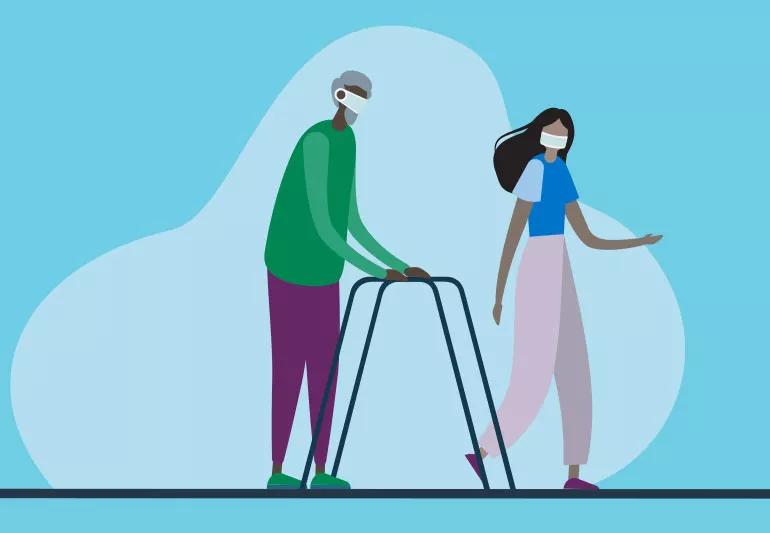Keep your grandparents and others safe

One of the constant refrains we’ve heard throughout the pandemic has been that older adults have an increased risk of infection and serious illness if they contract the virus. And that’s meant a lot of separation between kids and grandparents.
Advertisement
Cleveland Clinic is a non-profit academic medical center. Advertising on our site helps support our mission. We do not endorse non-Cleveland Clinic products or services. Policy
For over a year, you may have been tempted to throw caution to the wind and pay your older family members a visit. After all, with vaccines becoming more widely available, shouldn’t it be safe by now?
Geriatric medicine specialist Ardeshir Hashmi, MD, says that such a visit is possible, but only with careful planning and precautions. Here’s what to consider to make such a gathering possible – and safe.
First and foremost, Dr. Hashmi says you have to be on top of your own health first, which includes making sure you’re not showing any coronavirus symptoms. If you do, well, you better put that trip on hold. “It’s important to have ourselves checked and also be very judicious about waiting so that the symptoms are not with us for a good period of time,” he says.
The precautions don’t stop with you. Even if you’ve been symptom-free for 14 days and you’re ready to go visit your older relatives, you should also keep their health top of mind, too.
That’s because of the elevated risk of contracting the virus in older age groups, not to mention the higher mortality rate. These older members of your family are also more likely to have a condition that has a high co-morbidity with the virus, like cancer or heart disease or take medication that suppresses their immune systems.
Advertisement
If your family members have these conditions, and especially if there are multiple issues at play, Dr. Hashmi suggests reconsidering the visit.
But what if your older relatives are fully vaccinated?
That will still depend on your family’s circumstances and comfort levels. A person is considered fully vaccinated two weeks after their second dose of the Moderna or Pfizer vaccine and two weeks after the single dose of the Johnson and Johnson vaccine. It’s important that you abide by these timeframes so that your older family member’s immune system has time to process the vaccine so they are protected.
If your older family member is fully vaccinated, the CDC has said it’s safe for one household to now gather with them, indoors. This means that grandparents who are fully vaccinated can now visit maskless, indoors with their low-risk, unvaccinated children or grandchildren who all live under the same roof.
If everyone’s health is at a level that makes a visit safe, you’ll need to be on top of all the necessary social distancing and vaccination guidelines. These can vary by city and state, so if long-distance travel is involved, you’ll need to account for additional travel logistics such as mode of transportation (car versus an airplane, for instance) and any lodging accommodations you’ll need.
If you’re visiting older family members in a nursing home or retirement community, those locales will likely have their own set of guidelines, too.
Ideally, your visit can take place outdoors to help increase physical distance and to decrease the likelihood of letting any possibly virus-laden air droplets hang around. If you have to meet inside, try to open a window or two to help increase the circulation of fresh air.
And, again, don’t forget about the six-foot distance and masks to help ensure as safe an environment as possible.
“It’s still a visit, but a different visit where the solid core guidelines of vaccination, frequent hand washing, social distancing and wearing masks are absolutely key,” said Dr. Hashmi.
Advertisement
Learn more about our editorial process.
Advertisement

The short answer: It’s complicated, but the basic care precautions still prevail, like washing your hands and isolating if you’re sick

They can feel like a typical headache or a migraine headache, but the pain can last for weeks to months

Any large social gathering — from a family birthday party to an indoor music concert — has the potential to spread serious infection

It’s important to connect with a healthcare provider, get quality sleep and balance your activities with your energy levels

Just like the flu, COVID-19 will continue to evolve every year

The duration varies, but symptoms can linger for a few days up to a couple weeks or more

Vaccination is best for prevention, but if you get sick with COVID-19, treatments are available

The virus lives best in humans, but it can last on hard surfaces, like doorknobs and railings

Type 2 diabetes isn’t inevitable with these dietary changes

Applying a hot or cold compress can help with pain